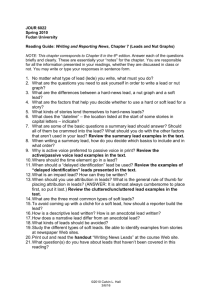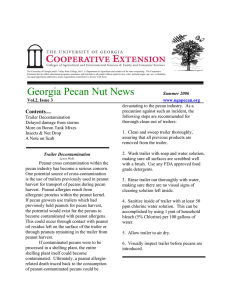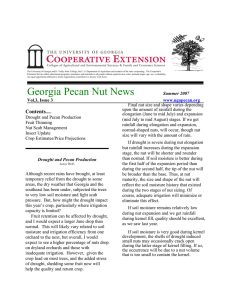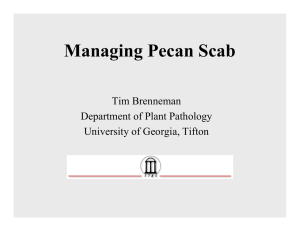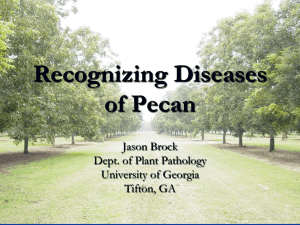Cooperative Extension Service The University of Georgia
advertisement
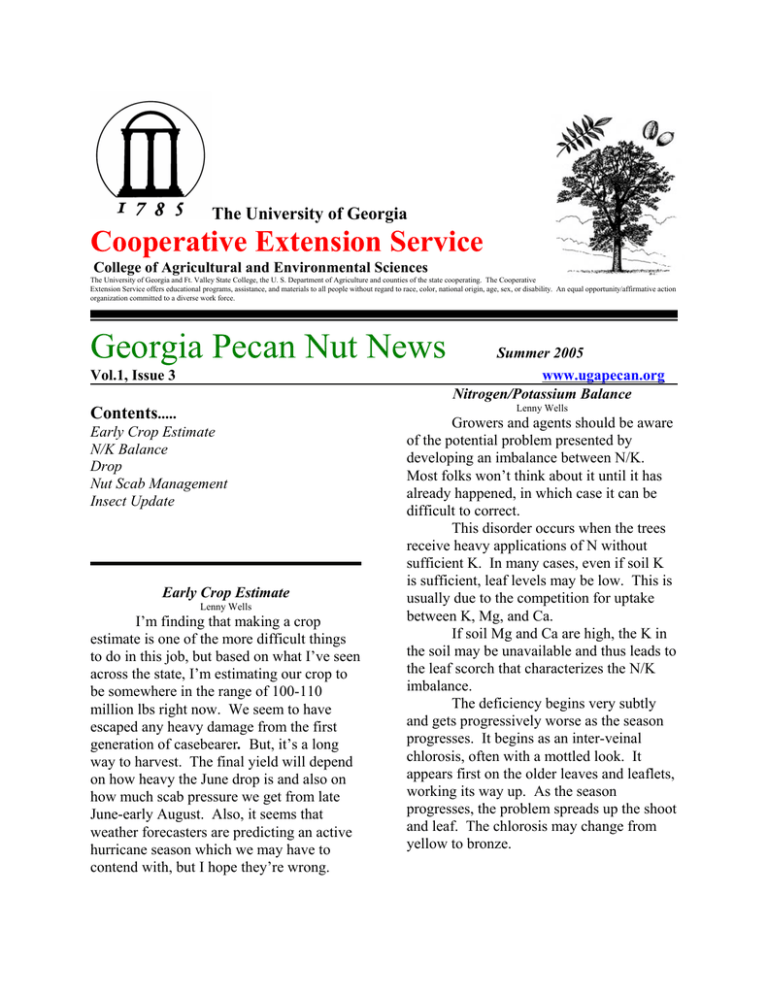
The University of Georgia Cooperative Extension Service College of Agricultural and Environmental Sciences The University of Georgia and Ft. Valley State College, the U. S. Department of Agriculture and counties of the state cooperating. The Cooperative Extension Service offers educational programs, assistance, and materials to all people without regard to race, color, national origin, age, sex, or disability. An equal opportunity/affirmative action organization committed to a diverse work force. Georgia Pecan Nut News Vol.1, Issue 3 Summer 2005 www.ugapecan.org Nitrogen/Potassium Balance Lenny Wells Contents..... Early Crop Estimate N/K Balance Drop Nut Scab Management Insect Update Early Crop Estimate Lenny Wells I’m finding that making a crop estimate is one of the more difficult things to do in this job, but based on what I’ve seen across the state, I’m estimating our crop to be somewhere in the range of 100-110 million lbs right now. We seem to have escaped any heavy damage from the first generation of casebearer. But, it’s a long way to harvest. The final yield will depend on how heavy the June drop is and also on how much scab pressure we get from late June-early August. Also, it seems that weather forecasters are predicting an active hurricane season which we may have to contend with, but I hope they’re wrong. Growers and agents should be aware of the potential problem presented by developing an imbalance between N/K. Most folks won’t think about it until it has already happened, in which case it can be difficult to correct. This disorder occurs when the trees receive heavy applications of N without sufficient K. In many cases, even if soil K is sufficient, leaf levels may be low. This is usually due to the competition for uptake between K, Mg, and Ca. If soil Mg and Ca are high, the K in the soil may be unavailable and thus leads to the leaf scorch that characterizes the N/K imbalance. The deficiency begins very subtly and gets progressively worse as the season progresses. It begins as an inter-veinal chlorosis, often with a mottled look. It appears first on the older leaves and leaflets, working its way up. As the season progresses, the problem spreads up the shoot and leaf. The chlorosis may change from yellow to bronze. Necrotic spots may also develop, which helps to distinguish K deficiency from N deficiency. As the K level continues to decrease, the leaves dry out and drop. Not surprisingly, the fruit drops afterward due to the tree’s inability to supply the nuts. This premature defoliation can be devastating to an orchard. Desirable and Schley are especially sensitive to this problem. Carefully monitor soil and leaf levels of K, Mg, and Ca to prevent this problem and do not over-apply N. Keep N/K ratios at 2:1. To properly manage the K, Ca, and Mg, use the following equation based on your leaf levels: K/Ca+Mg Ideally, this number should be below 0.5 in order to prevent leaf scorch due to N/K imbalance. If the problem occurs and soil levels of K, Ca, and Mg are sufficient or high, there is little that can be done. Virtually the only treatment is to apply foliar Potassium nitrate with each fungicide spray. Even this may not completely stop the problem. If orchards are low in K and also need lime, some research indicates that doubling the amount of K that would normally be put out on an un-limed orchard helps to overcome the competition with the Ca and Mg in the lime. during a year following a heavy nut crop, the entire cluster may be lost. The second drop occurs in mid to late June and is due largely to conditions that prevent fertilization. The third drop occurs in late July to early August. It results from embryo abortion and increases with self-pollination. A variety of other factors may lead to nut drop as well and whenever a drop occurs, the cause of the drop should be determined. Insects, disease, environmental conditions, and improper nutrition can also lead to nut drop. Often an insect-induced drop can be difficult to diagnose in the absence of obvious feeding holes and characteristic markings created by some insects. One diagnostic characteristic to distinguish physiologically-related drop from insect induced drop is the presence of a necrotic ring between the shuck and nut where insects are the culprit (pictured below). When no dark ring is present and the shuck can be easily peeled away from the shell when the tip is cut off, the problem is likely nutritional or due to pollination difficulties. Drop Lenny Wells Nut drop is a common occurrence during the summer each year. Sometimes, in heavy crop years, the nuts will need a little thinning anyway. There are at least 3 distinct drops that occur in pecan which are physiologically induced. The first drop occurs during mid-May after pollination. This is usually due to weak flowers and Pollination Problem Insect Induced Nut Scab Management Jason Brock Attention has shifted from management of leaf scab to nut scab. The period of nut expansion is the most critical time of the season for protection. Timely fungicide applications and good coverage will be important. There are a couple of other points to be made concerning control of nut scab. The critical factor in the development of nut scab will be weather, mainly rain events. Areas with little leaf scab could still be hit hard with the right environmental conditions. In contrast, locations with high incidence of leaf scab could if little nut scab is there is lack of rain. The point I want to make is this, do not let the level of leaf scab overly influence nut scab development. While the initial inoculum level may be important, the driving force behind scab epidemics will be rainfall. A realistic goal is to reduce the severity of scab, not complete elimination. Not only would the cost be too great, but completely eliminating scab is not practical. While nut size can be reduced by light scab, nut drop and reduction in percent kernel occur when scab severity is high. Protect nuts early and stay on a well timed spray program to reduce the damage caused by nut scab. As always, make sure that your season long spray program follows resistance management guidelines. juice”) stain around it. Curculio is a fairly uncommon and sporadic pest that many growers never have a problem with, but hickory shuckworm is widespread and can cause significant losses. By the time a grower realizes nut curculio is active there is probably little that can be done. They can be controlled with the same treatments used for weevils, but applying Sevin or a pyrethroid in June is likely to cause more problems with mites and aphids than the curculio itself would cause. Shuckworm can be controlled effectively with the same materials used for casebearer. Dates to Remember Leaf Samples: July 7-August 7 Georgia Pecan Growers Association Fall Field Day September 8, 2005 Rural Development Center Tifton, GA A noon meal will be served Call 229-386-3410 for information Insect Update Will Hudson Growers should be looking for dropped nuts under their trees at this time of year. We expect a drop now from Desirables, but all varieties drop nuts for a variety of reasons. Of particular concern are those nuts that drop due to Hickory Shuckworm or Nut Curculio feeding. Shuckworm damage usually leaves a small hole with a white powdery residue around it on the side of the nut. Curculio damage leaves a hole with a brown liquid (“tobacco Edited by Lenny Wells Extension Horticulturist-Pecans Contributers: UGA PECAN TEAM Jason Brock, Ext. Pathologist-Pecans Will Hudson, Ext. Entomologist-Pecans Paul Sumner, Ext. Ag. Engineer-Pecans Lenny Wells, Ext. Horticulturist-Pecans

